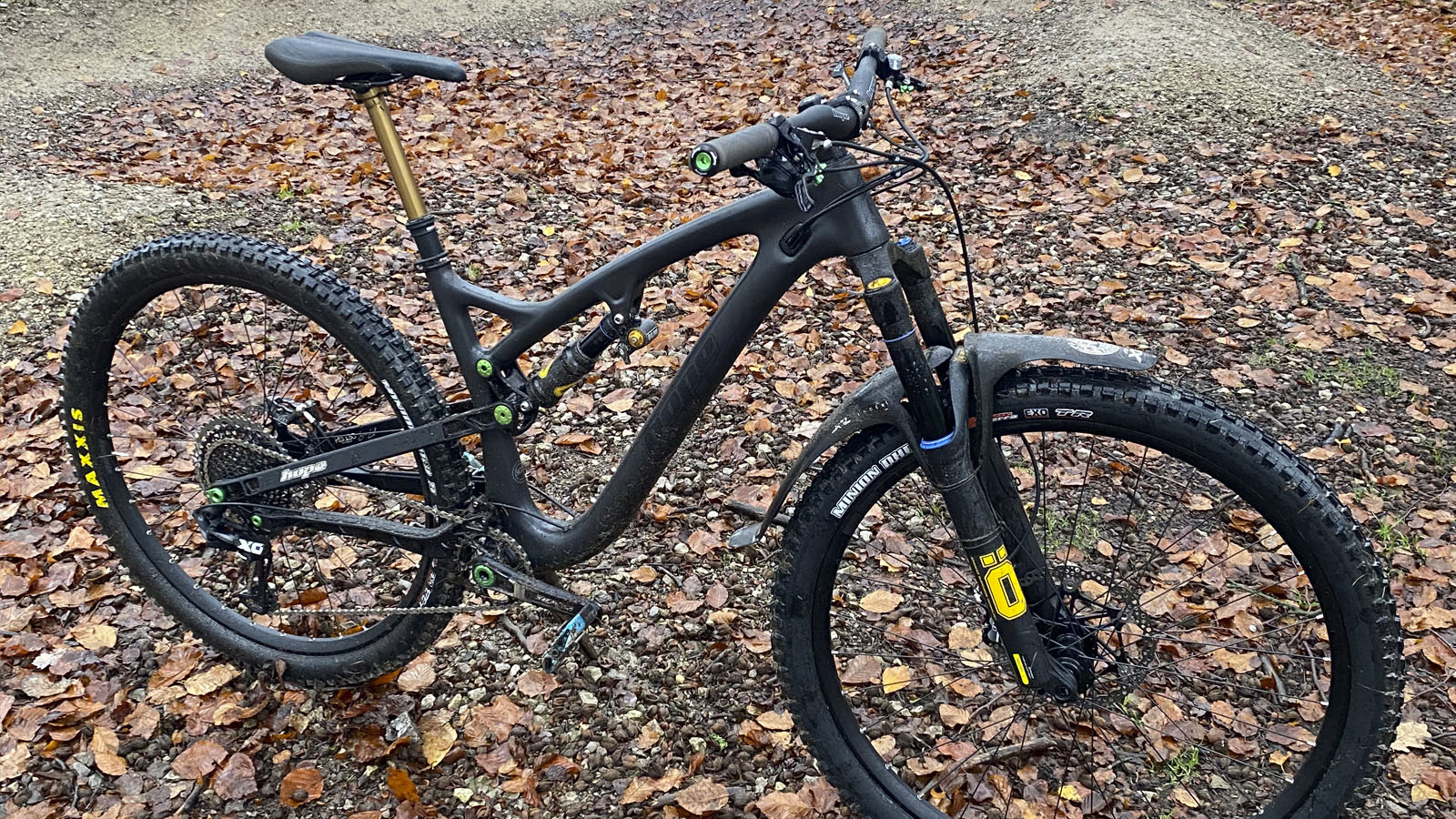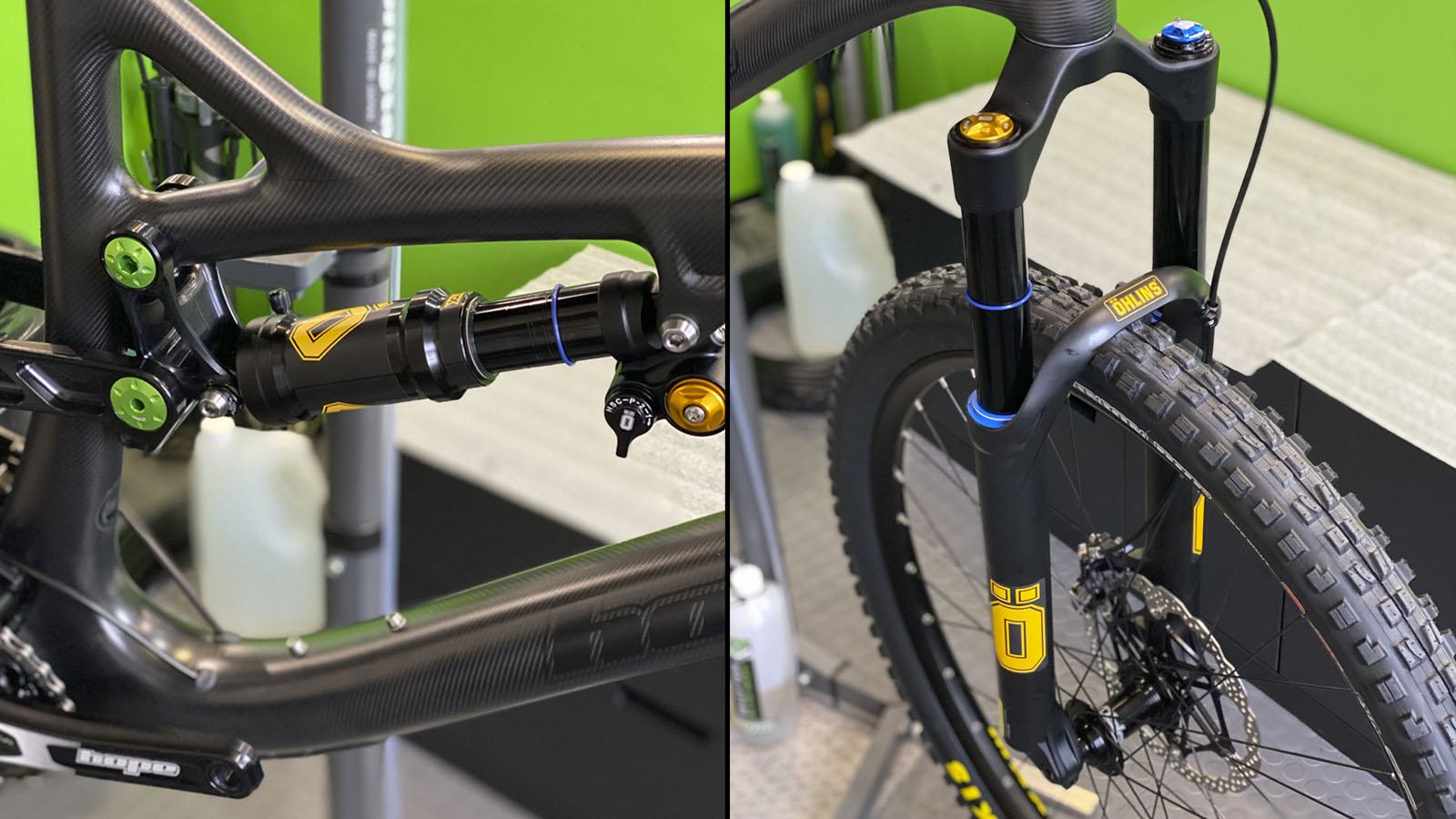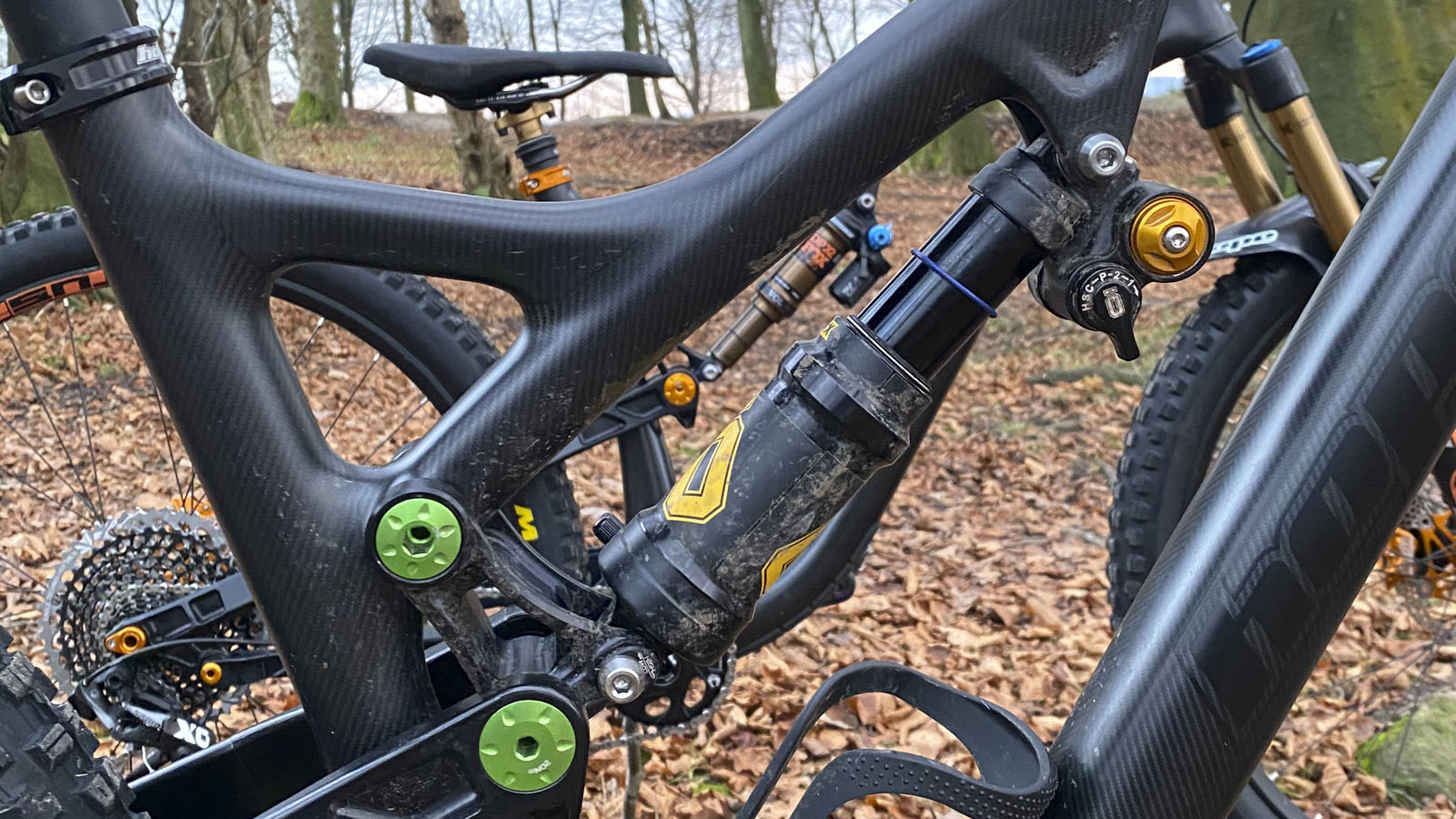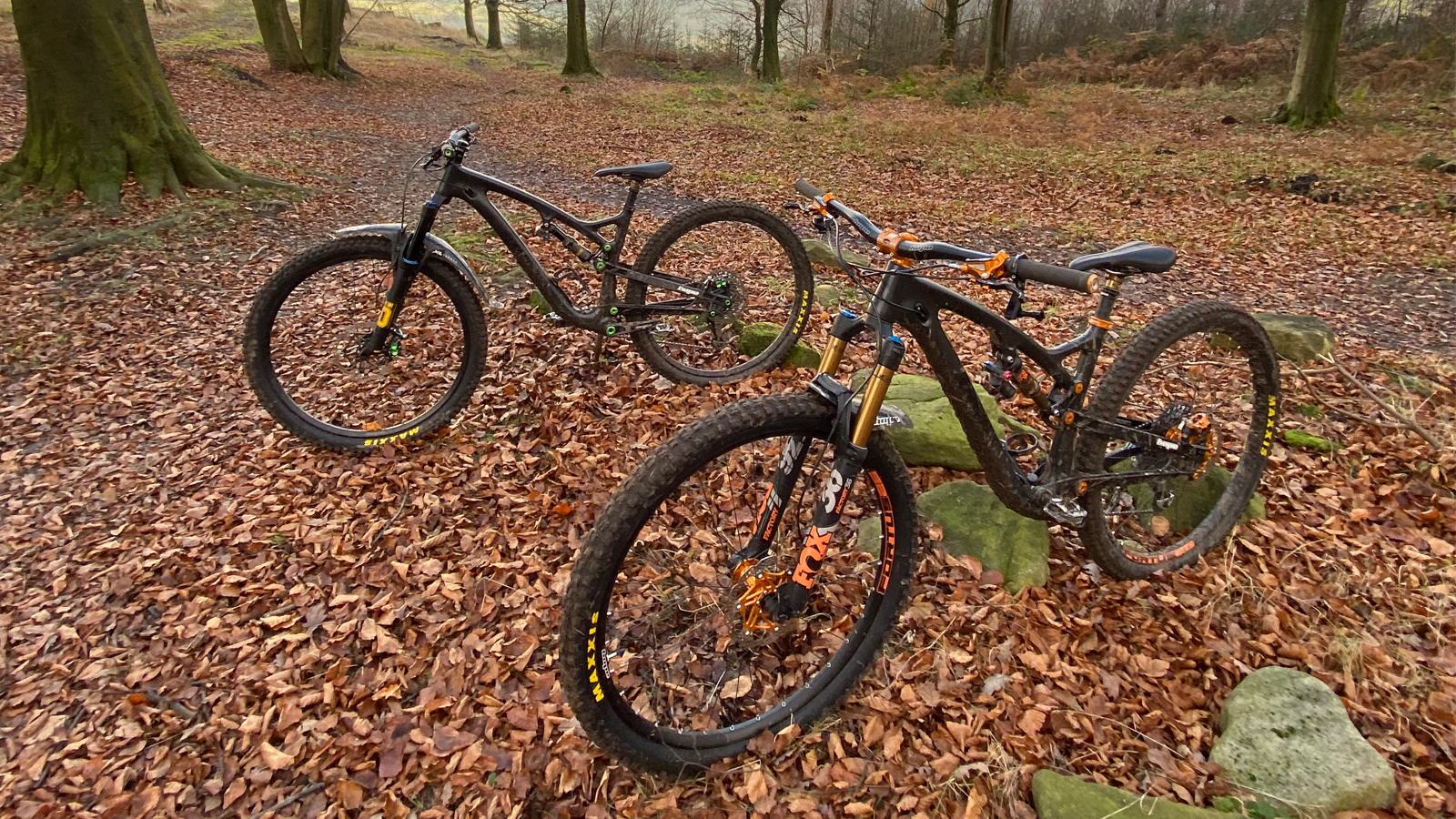Bike Perfect Verdict
A capable trail bike with the option of plush or aggressive personalities
Pros
- +
Next-level UK build quality and backup with extensive custom options
- +
Well balanced contemporary geometry and neutral suspension kinematics
- +
Combat or comfort optimised suspension options
Cons
- -
Noticeable rear-end flex under peak load
- -
Limited tyre space and unique rear-hub sizing
Why trust BikePerfect
HB130 is the second complete trail bike from Lancashire component legends Hope Technology. It takes lessons learned from the original HB160 650b-wheeled 160mm travel enduro bike and translates them into a lighter, faster, more progressively shaped 29-inch-wheeled, 130mm travel aggro all-rounder. That puts it in the thick of the action of the fastest developing category of mountain bikes, where cross-country speed meets downhill suspension and geometry influences.
Where the Hope stands out is its almost entirely in-house UK construction with an unashamedly indulgent level of detailing. While it’s more mainstream component compatible than the HB160, it still runs a unique narrow stance back end. But are Hope’s claims of increased stiffness and reduced chance of trail damage true? And does sculptural machining, custom anodised aesthetics and 179 pieces of composite build a competitive bike on the trail?

Design and geometry
Those aren’t just 179 pieces of imported carbon fibre either. Hope has always prided itself on producing as much of every component it can in its own factory. In this case, three different types of carbon - unidirectional, 3k cross weave and 1k impact weave - are woven in Manchester, impregnated with resin in Lincolnshire and then hand laid into moulds machined in-house by Hope. The cured and baked mainframes are then hand sanded, lacquered, resanded, decaled and then lacquered again leaving the weave clearly visible under a mud-shrugging clear coat. Lessons learned on the HB160 mean the alloy frame fixtures are added into pre-moulded pockets for maximum accuracy and strength. Although there are more pieces of carbon and it’s a longer mainframe than the HB160, the HB130 is also 150g lighter with Hope claiming a weight of 2.76kg for a large frame and shock.
The rear swingarm uses extensively machined and pocketed, single-piece L-beam chainstays pivoting on similarly sculpted dropout sections. While the brake is now a conventional post mount (HB160 was a unique radial design), Hope has stuck with a 130mm width, 17mm diameter axle and matching hub. Triangular extruded seat stays (the only metal parts not made on-site by Hope) are bonded into the end sections to avoid the potential distortion caused by welding. Immaculate alignment certainly means ultra free movement with the shock removed but tyre clearance is limited to a knobby 2.3in. The bottom bracket also spins noticeably more smoothly than normal on unique oversized 47mm bearings. According to Hope, they’ve not sent one HB frame to landfill yet and they’ve made over 400, and the company applies the same legendary in-house support to any frame issues, should any arise.
While the mainframe is naked carbon and rear end is anodised black (in-house) there are several decal colour options and the machined and laser-etched alloy hardware is available in Hope’s usual seven colour palette which you can match or clash to taste. Bolts are all titanium too and there’s rubber armour on the belly and the chainstay top. You can only currently get the frame in medium, large and extra-large though, and while there is a bottle mount, you’ll need a side-loading bottle cage for easy extraction.
Components and build
Hope offers a frame kit (£3950/€4700/$4950) but we tested the complete bike option. These come loaded with Hope's own Tech E4 brakes (other Hope lever and caliper options are available), 35mm stem and handmade carbon handlebar with Hope grips. The Pro4 front hub and narrow stance rear hub are laced onto Hope’s Fortus 26mm rims or you can add Santa Cruz’s lifetime warrantied Reserve carbon rims for a 125g (22 per cent) saving per wheel.
Converting the Maxxis Minion DHF 2.5WT 3C MaxTerra front and DHR 3C Exo 2.3in rear tyres to tubeless is an optional upgrade, and there’s not much room for anything bigger in the narrow rear end. Gearing is SRAM X01 Eagle and while bikes are supplied with a SRAM carbon chainset, you can swap to Hope’s own chainset at a reduced price. A custom logo SDG saddle sits on a Fox Transfer dropper post and bikes can be ordered with a 140mm travel Fox 36 GRIP2 Factory suspension fork and DPX2 Factory rear shock. Ohlins RFX 36 M.2 air or coil fork and TTX Air rear shock are available for the same price, while a TTX coil shock sees a £100 saving.

Ride, handling and performance
While the construction changes and lower weight compared to the HB160 are evolutionary plus points, the big leap in the dynamic DNA of the HB130 is much more progressive geometry. The 66-degree head angle and 44mm fork offset produce a naturally stable yet still easily tweaked steering character. The lighter, longer front end is still stiff enough too, so feedback from the 36mm legged forks and big 2.5in wide tyre up front is excellent. The 75.7-degree seat angle and a 470mm reach (large) centres the rider forward for maximum front-wheel grip through corners or up technical climbs too. If that sounds a bit too rad, you can steepen the front by half a degree and bring the bottom bracket up with a flip-chip on the shock mount.
The main pivot above and slightly behind the bottom bracket means a super neutral, low pedal growth/anti-squat suspension character. Add a digressive shock rate offsetting natural air shock progression and the back end is mechanically very mobile in response to weight shifts or trail trauma. That makes the difference between the Fox and Ohlins suspension very clear on back-to-back runs. The Fox DPX2 is plush off the top and well-controlled deeper in the stroke but the mid-stroke lacks firm support for aggressive riding. There’s reduced scope to stiffen it up with volume spacers compared to most shocks too. That meant we had to rely on the ‘pedal’ setting to add some stability and even then it wasn’t particularly predictable.
That bagginess definitely makes the Fox option best suited to comfort hunters rather than corner carvers. In contrast, the Ohlins equipped bike feels like a massively overdamped and constipated mess in the car park and definitely patters and taps more over roots and rocks at low speed. After spending three days trying to make it feel plusher, we gave up and embraced the very controlled feel by adding more low-speed compression and increasing pressure so it sat at around 18 per cent sag. That put the TTX damper back into its sweet spot and, while it still felt firm on easy roll downs, the control and support through ragged, staccato sections and big boulder fields was outstanding. The RFX fork feels exactly the same too, giving the HB130 a real rally car feel that feels better and better the harder you push on more challenging trails. The wide range of damping adjustment on the Fox 36 GRIP2 damper means you can set that up to match the Ohlins fork (while retaining better slow-speed sensitivity) though so it’s really the rear shock that makes the big difference.

Noticeable flex in the machined back end helps the Hope shrug and snake through rocky and rooty sections and hook into scooped turns. It also helps reduce square edge impact shock and the narrower stance means less chance of smashing the mech on a rock. It can wander and warp offline under power though, and despite the easy spinning bottom bracket, there’s a definite sense that not all your drive is reaching the rear wheel at full gas. We’d be wary of trying to squeeze a bigger tyre in as there’s enough wheel wag to make scuffing the swingarm under cornering load a definite danger.
In contrast, the super stiff Hope handlebar and wooden feeling - rather than progressively powerful - Hope brakes mean your arms suffer sooner than usual on punishing or technical descents. Hope’s crankset is also 100g heavier than the standard-issue SRAM. While we didn’t get the chance to try the two sets back-to-back on the HB130, having tested both the Hope alloy wheels and Santa Cruz carbon wheels in the HB160 we’d definitely say the extra money is worth spending for a palpably livelier, more responsive trail feel.
Verdict
Hope’s HB130 is definitely a big step forward for the Lancashire company. Weight is now competitive and the geometry is well balanced for bossing technical trails. While rear-end flex saps accuracy and energy under peak load, it’s more forgiving in rooty/rocky mess and helps shrug off serious slams. The suspension is totally neutral, sucking up trail trauma and laying down traction with minimal feedback on climbs. The choice of Fox or Ohlins dampers gives dramatically different ‘comfort’ or ‘combat’ characters to the basic chassis, too. In other words, it’s basically a well-sorted, mid-travel 29er with all the impressive technical trail capability that comes with that breed.
The reason most people will pick out the HB130 is the ‘Best of British’ backstory and gorgeously indulgent hand-built detailing. Hope’s legendary backup, pick and mix customisation options and the chance to go and meet its rightfully proud makers in person at the factory where it (nearly) all happens, make the price seem relatively reasonable.
Those same people will likely be happy to overlook the below-par brake performance, punishing handlebar stiffness, limited tyre clearance and specific rear hub awkwardness of the collar-and-cuffs componentry. Choosing the frame option dodges some of those issues though and whatever your opinion, Hope’s truly artisan, homegrown ethos deserves serious respect and recognition in a world of increasingly similar offshored options.
Tech Specs
- Model name: Hope HB130
- Discipline: Trail/Enduro
- Price: £6299.99
- Head angle: 66
- Frame material: Carbon fibre mainframe, machined and bonded alloy rear end.
- Size: M, L (tested), XL
- Weight: 14.1kg (without pedals)
- Wheel size: 29er
- Suspension (front/rear): Ohlins RFX26 M.2 (140mm) and TTX Air (130mm) or Fox 36 Factory GRIP2 (140mm) and Factory DPX2 (130mm)
- Drivetrain: SRAM X01 Eagle gears with Hope Evo or SRAM X01 carbon crank
- Brakes: Tech 3 E4 brakes with 180mm floating rotors
- Tyres: Maxxis Minion DHF 2.5in WT 3C Max Terra front and Minion DHR 2.3in 3C EXO TR rear
- Wheels: Hope Fortus 26mm rims on Hope Pro 4 hubs (custom 130mm rear)
- Bar/stem: Hope Carbon 780mm bar, 35mm stem

Guy Kesteven has been working on Bike Perfect since its launch in 2019. He started writing and testing for bike mags in 1996. Since then he’s written several million words about several thousand test bikes and a ridiculous amount of riding gear. He’s also penned a handful of bike-related books and he reviews MTBs over on YouTube.
Current rides: Cervelo ZFS-5, Specialized Chisel, custom Nicolai enduro tandem, Landescape/Swallow custom gravel tandem
Height: 180cm
Weight: 69kg

